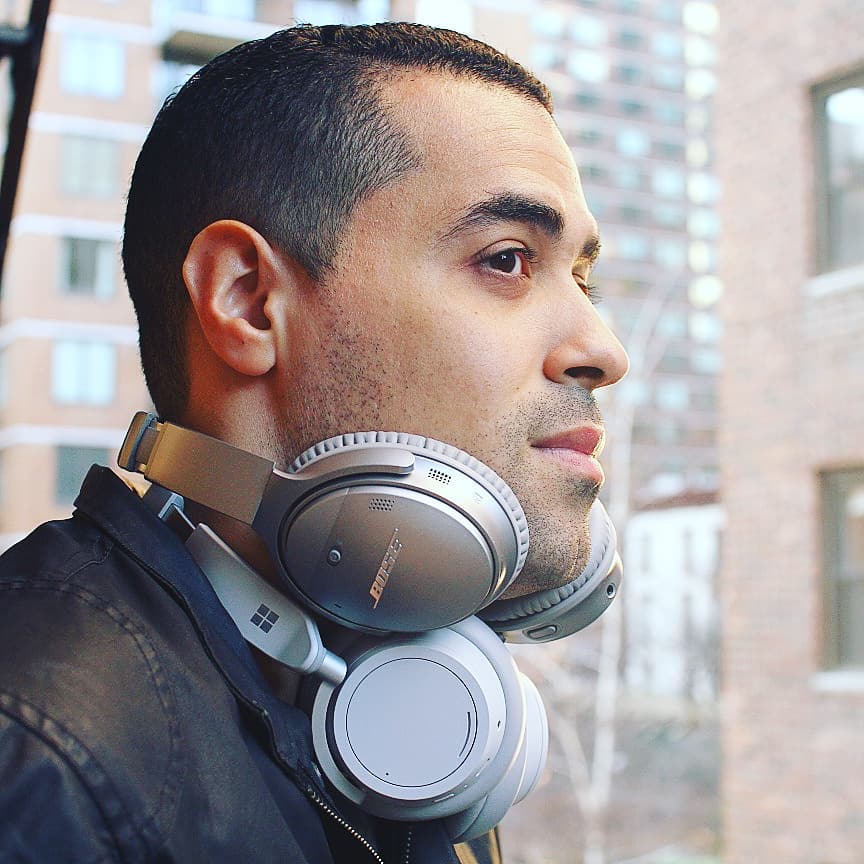Tom's Guide Verdict
While they don't rise to the standard set by Bose and Sony, the Microsoft Surface Headphones are a pleasant surprise with solid sound and noise cancellation.
Pros
- +
Spacious soundstage
- +
Adjustable noise cancellation
- +
Innovative dial and touch controls
- +
Excellent connectivity
- +
Comfy and premium design
- +
Supports multiple Bluetooth devices
Cons
- -
Battery life is lower than the competition's
- -
Cortana app is necessary for most features
- -
Bass can come on too strong
Why you can trust Tom's Guide
Riding on the success of the Surface brand, Microsoft has expanded its reach into the audio space with the Surface Headphones. Engineered in-house by the Surface team, these active noise-cancelling cans borrow much of the same design elements as the product's computing brethren, while bringing forth dynamic sound and unique controls.
The result is a stylish set of cans with solid audio performance and surprisingly potent active noise cancellation. But can the Surface Headphones compete against category savants such as the Bose QuietComfort35 II and Sony WH-1000XM3?
They're close, which is why they initially made our lists of best headphones, best wireless headphones and best noise cancelling headphones. But newer models have since replaced the three-year-old Surface Headphones.
Microsoft must have taken notice. It just unveiled the Surface Headphones 2, a follow-up to the pair in this review with a longer battery life, better ANC levels and live caption technology.
Design
Combining adaptive ergonomics with durable build quality and a sleek platinum finish, the Surface Headphones are an attractive pair of cans. My only wish was that they came in the same sexy Black color scheme as the Surface Pro 6. But their true beauty is in the details, and the Surface Headphones have several that you'll spend time admiring.
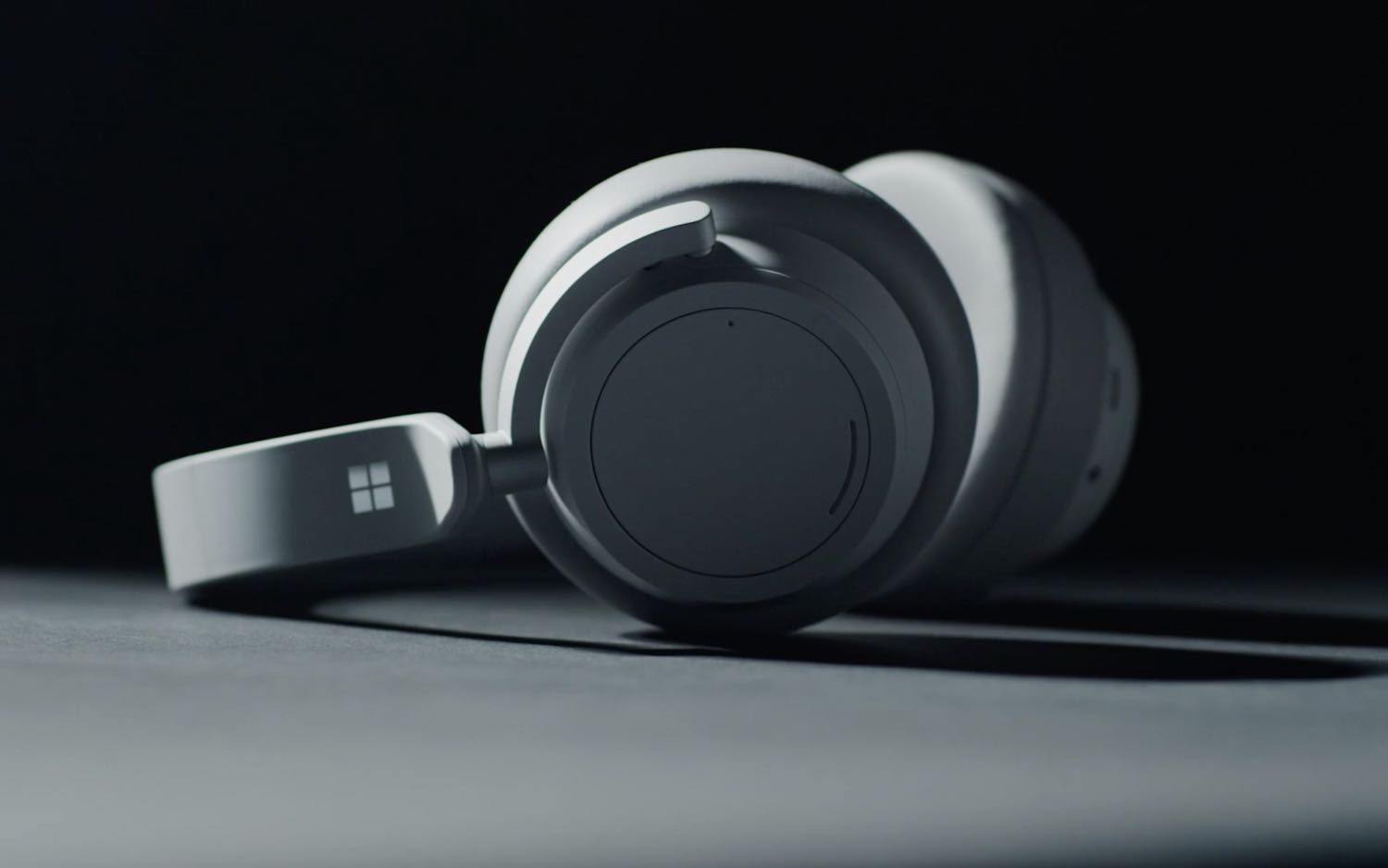
The cans' construction consists of aluminum (extenders), plastic (ear cups) and steel (headband). Each one of these components is firm and pliable, ensuring the pair survive whatever abuse you put them through. The soft-touch exterior feels great, plus the metal and plastic give off a nice shine factor that plays into the headphones' premium appearance.
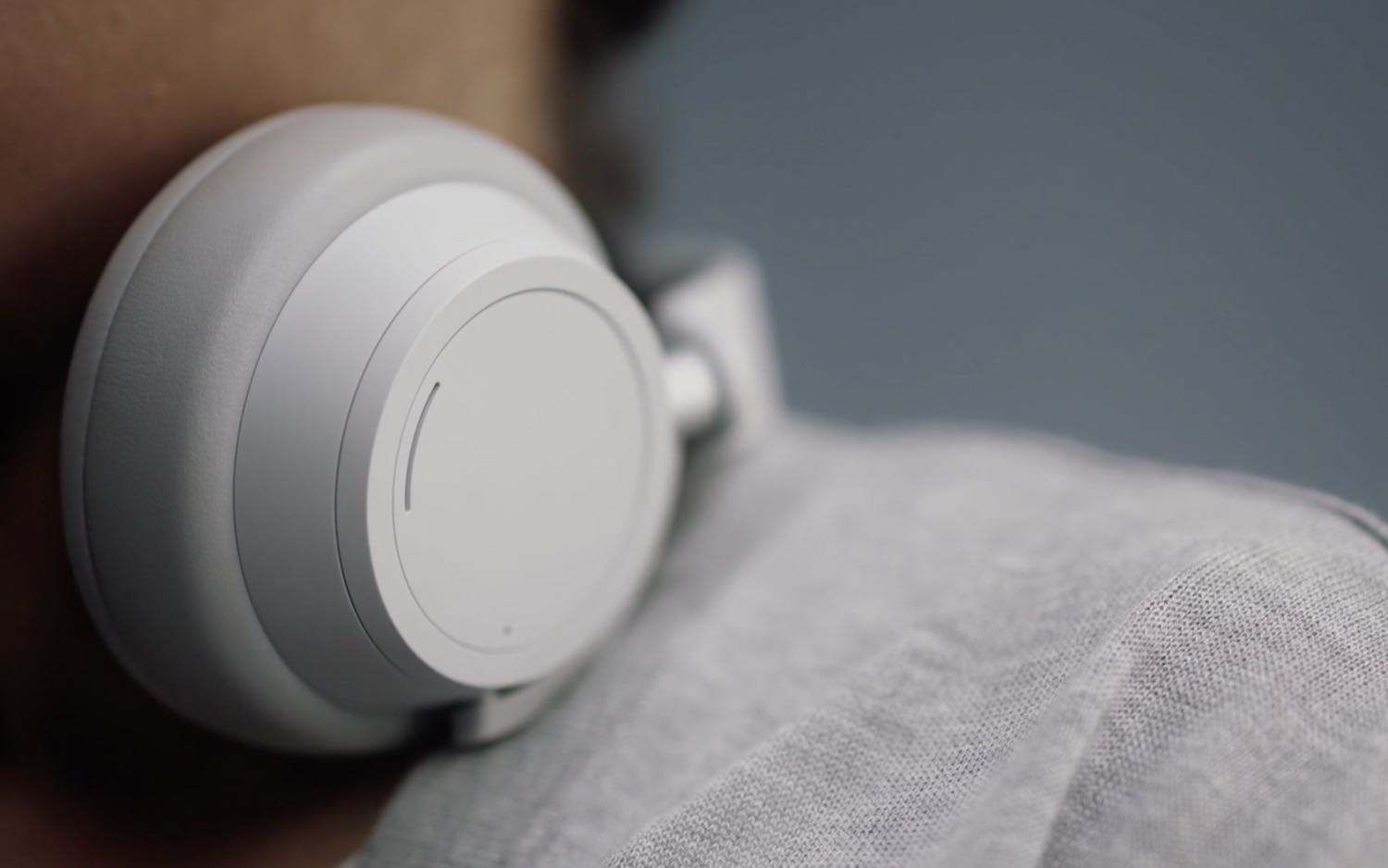
Adding to their charm is the silver Windows logo, which is more eye-catching than Bose's and Sony's imprints. The distinct arc above the ear cups also makes the headphones stand out when worn. Last, the headphones maintain a uniform build. Every component looks molded together, unlike the Bose QuietComfort 35 II headphones, where you can see just about every screw in the frame.
Combining adaptive ergonomics with durable build quality and a sleek platinum finish, the Surface Headphones are an attractive pair of cans.
Microsoft bundles its cans with a handful of accessories, including an auxiliary and USB Type-C cable that come beautifully displayed inside a chic, woven travel case. The command sheet slipped inside with the accessories pouch is a crafty touch most owners will appreciate.
Comfort and Fit
At 10.2 ounces, the Surface Headphones aren't particularly light. Then again, neither is the QC35 II (8.2 ounces) nor the Sony WH-1000XM3 (9 ounces). In any case, the Surface Headphones offer the same relaxed comfort as the device's adversaries.
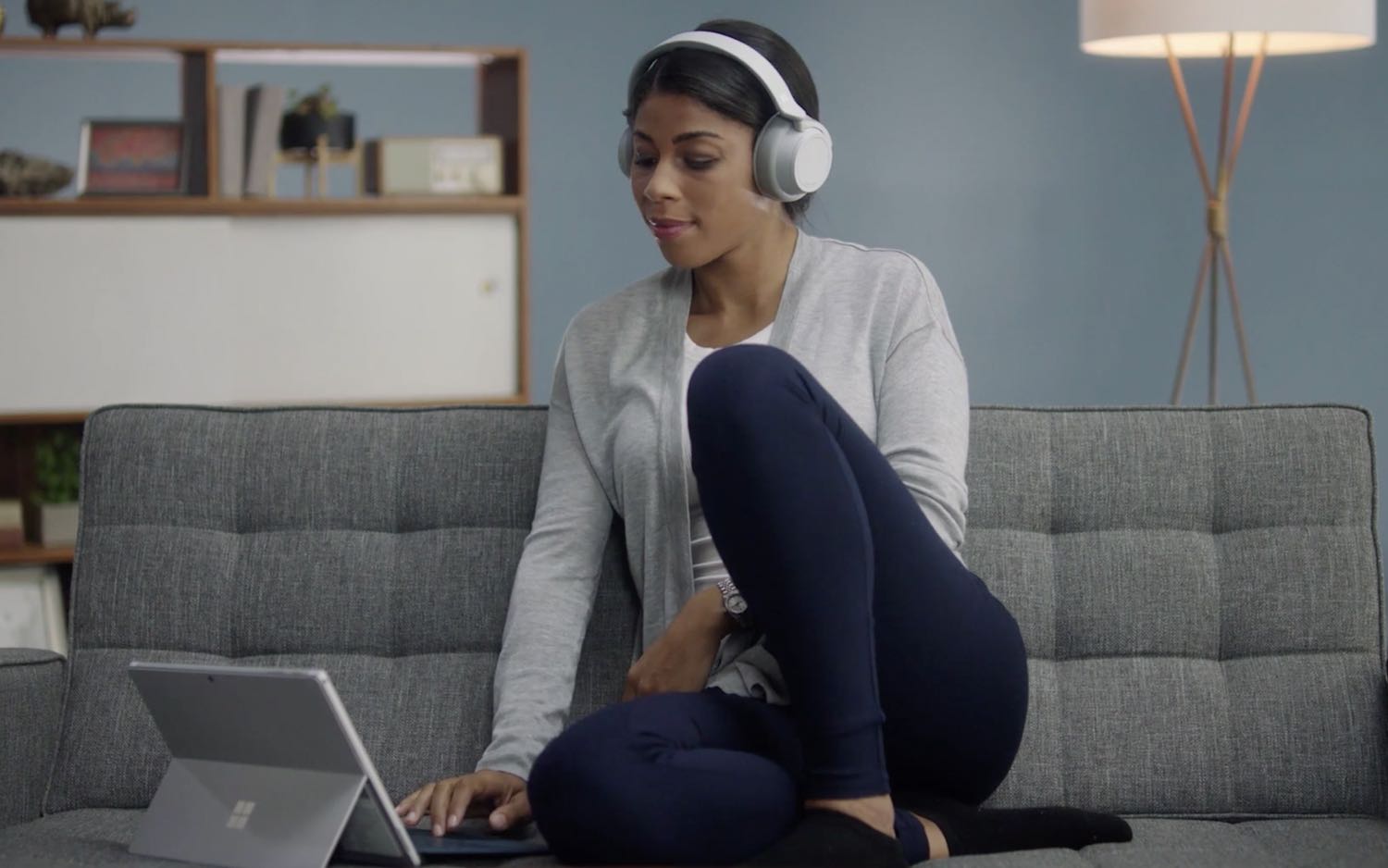
Let's start with the soft memory foam around the ear cups. It's plush and has a pillowy feel that's soothing on the ears. The WH-1000XM3 has an oval cutout, while the Surface Headphones boast a large, circular cutout.
The latter is more beneficial for two reasons: It accommodates wider ear sizes and prevents the padding from applying pressure to the cartilage in your ears. Unfortunately, this also provides little breathing room, creating a hot, sweaty environment for your ears. It can get muggy up there if you wear it for more than half of the day.
MORE: Best Headphones - Top Earbuds and Headphones
The headband has firm padding, which ensured the headphones locked onto my skull. Playing with the extenders was key to achieving a snug yet comfortable fit. Once settled on the right notch, the headband conformed to my noggin without applying unwanted pressure. I wore them for about 5 hours daily without ever feeling fatigued.
Intuitive Controls
The Surface team members outdid themselves by incorporating dial controls and a touch interface on both ear cups. The volume knob on the right raises sound when dialed forward and lowers sound when turned backward. The left knob works the same to adjust active noise cancellation. Each operates readily and precisely.
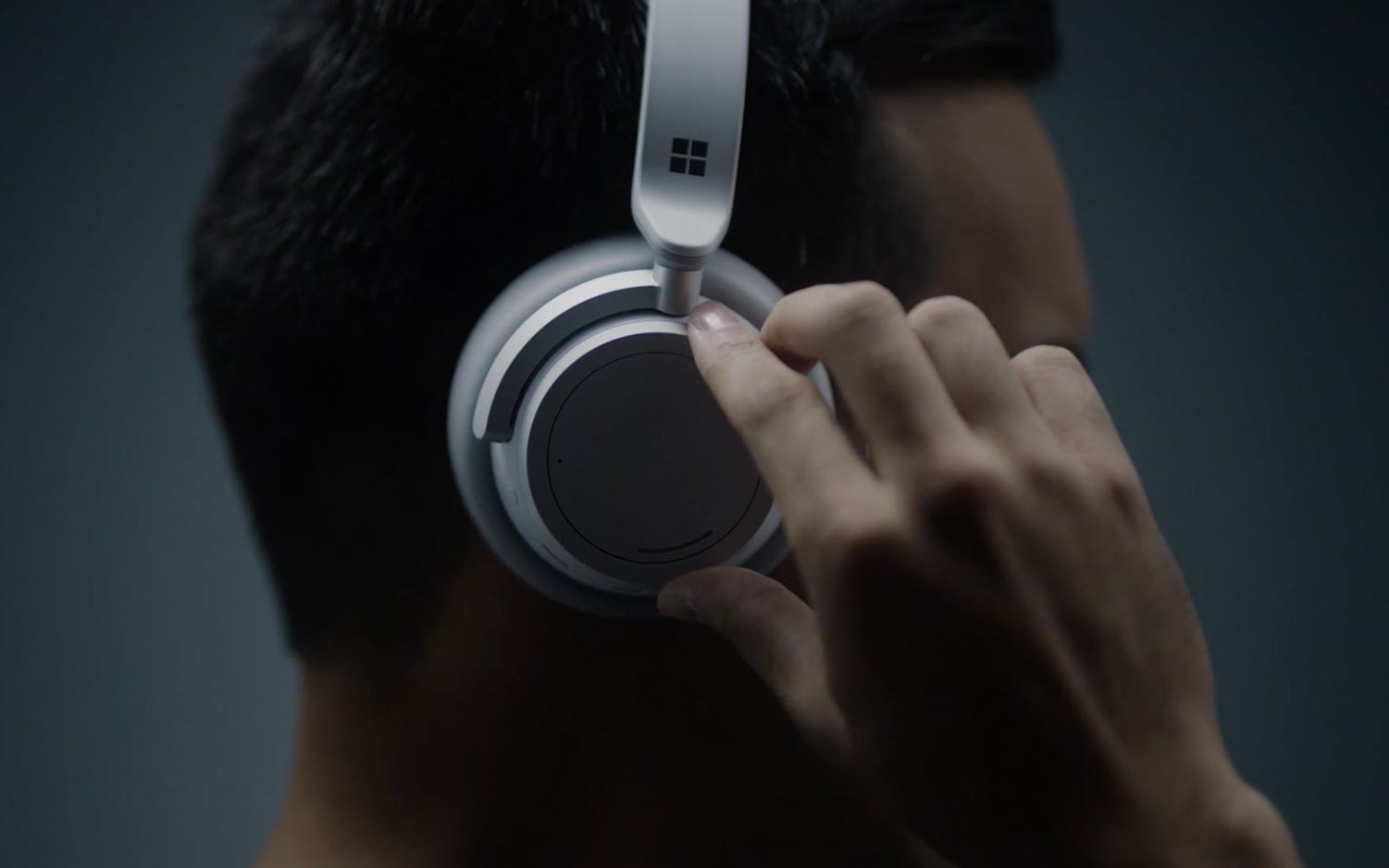
One of my favorite features of the WH-1000XM3 is the touch panel, and I was stoked to hear that the Surface Headphones wield the same trait. The luxury of managing calls and music playback from either side is convenient. The tap gestures are simple to learn: play/pause (tap once), answer call/skip song (tap twice), previous track (tap three time) and activate Cortana/decline call (long press).
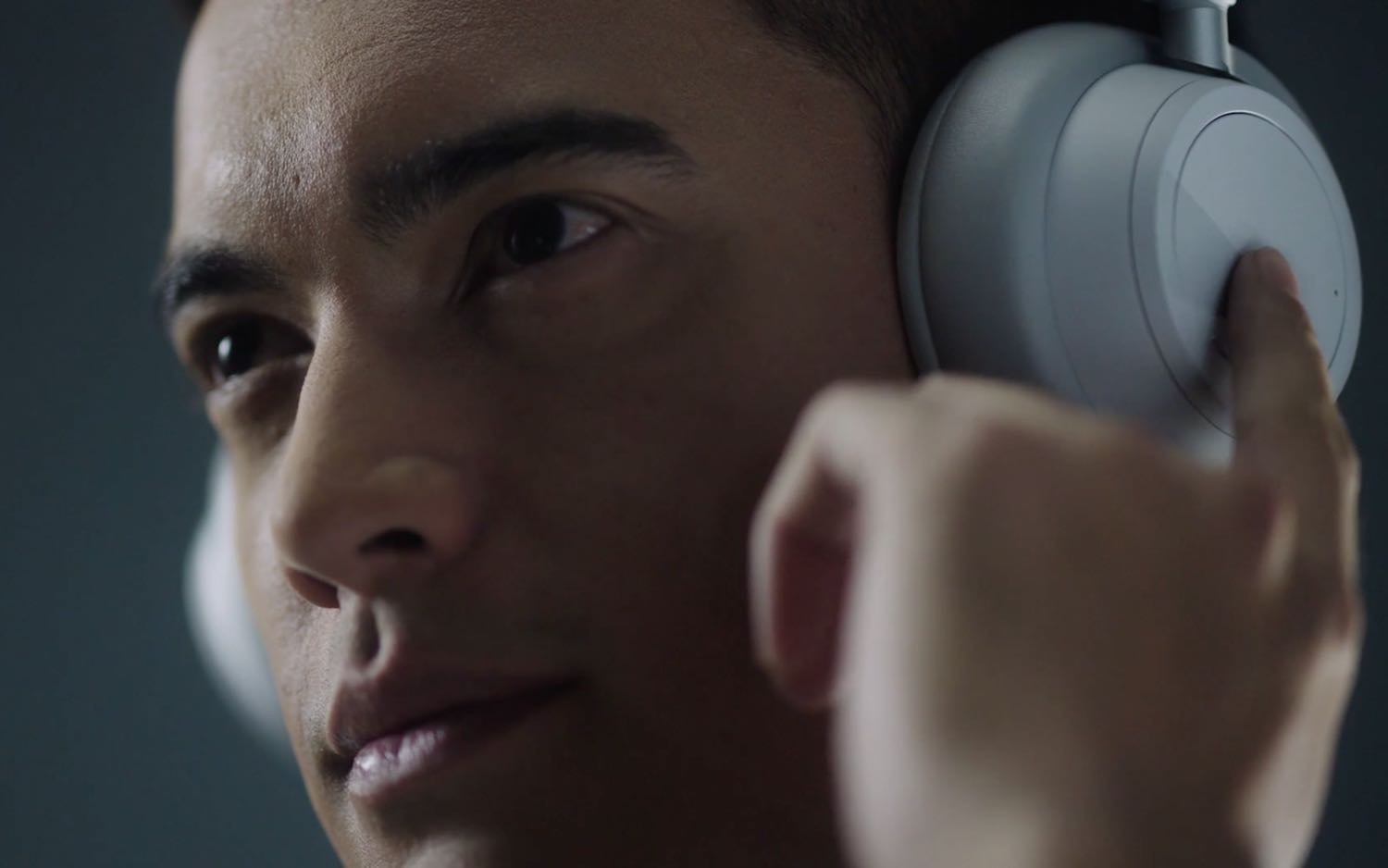
I also discovered you can initiate the play/pause function by performing circular gestures on the pad. While the Surface Headphones controls are responsive in execution, I thought the inclusion of swipe gestures on the WH-1000XM3's controls allowed them to work more smoothly and better optimize the technology.
Completing the control scheme are an audio jack, charging port, battery notification button and power button below the right ear cup. Holding down the latter for 20 seconds will factory reset the headphones.
MORE: Best Noise-Cancelling Headphones
There's also a smart-pause feature that stops music whenever you're taking the cans off your head – something Plantronics has done with its BackBeat Go series for many years. It's pretty accurate and pauses media when you're removing one ear cup for those moments when you have to interact with the outside world.
Active Noise Cancellation
Microsoft has initiated serious steps to make its sound silencers special – integrating eight microphones into the design to produce 13 levels of active noise cancellation. Four of those are beamforming mics that help improve voice clarity. The technology works well for neutralizing sound, but it's not as refined as Bose's or Sony's.
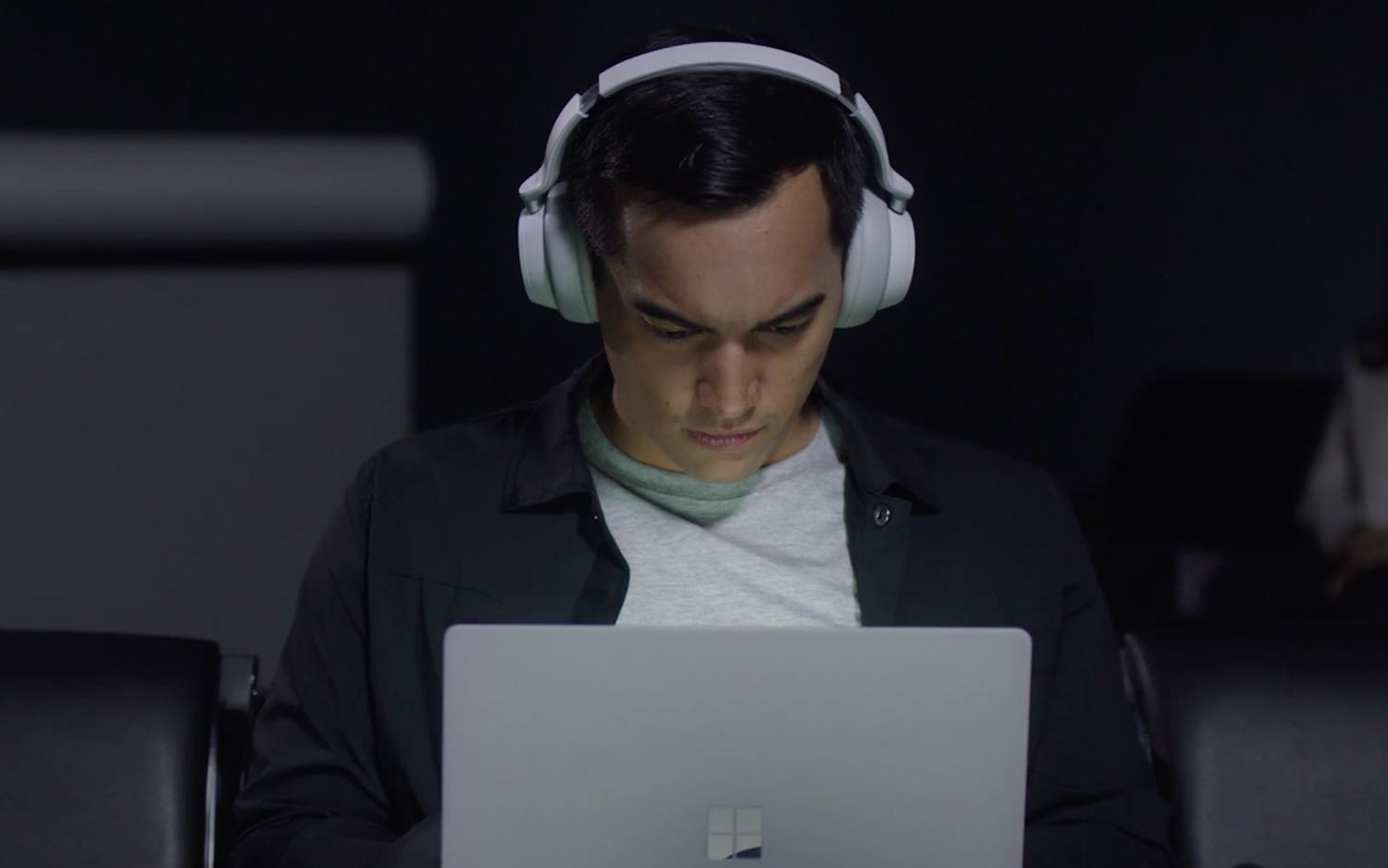
Most of the ruckus around me was silenced when I sported the headphones outside. I could barely hear any rush-hour traffic when heading to the subway, and the sound of angry commuters was muted on the train ride home. Wind was an unavoidable obstacle with the WH-1000XM3, but not with the Surface headphones. The mics weren't affected by drafty conditions and let me listen to Spotify when I was out and about, much like my experience with the QC35 II.
The active noise cancelling works well, but it's not as refined as Bose's and Sony's.
The Surface Headphones come programmed with an Ambient Noise mode, directing external sound from your surroundings into the headphones. It's a clever feature that's also found on the WH-1000XM3, which comes in handy when you want to hear environmental fracas or someone talk, but only at low volume. I wasn't able to identify certain noises when I was blasting music. There was also some noticeable hissing in the background when I was enabling the mode.
Noise Isolation
The Surface Headphones ' noise isolation is good, but the QC35 II and WH-1000XM3 do it better. The headphones blocked about 70 percent of sound in the streets. Still, I walked through rowdy crowds unbothered, although I was interrupted by church bells. Construction sites and nearby ambulance sirens also pulled me away from my music. Indoors, I could barely hear my door buzzer or girlfriend chatting with her mom on the phone.
Audio Performance
Does the sound quality on Microsoft's headphones match what Bose and Sony offer? No. Nor should any audiophile expect that. Be that as it may, the Surface Headphones do an impressive job of delivering powerful bass and spacious sound for an immersive listening experience.
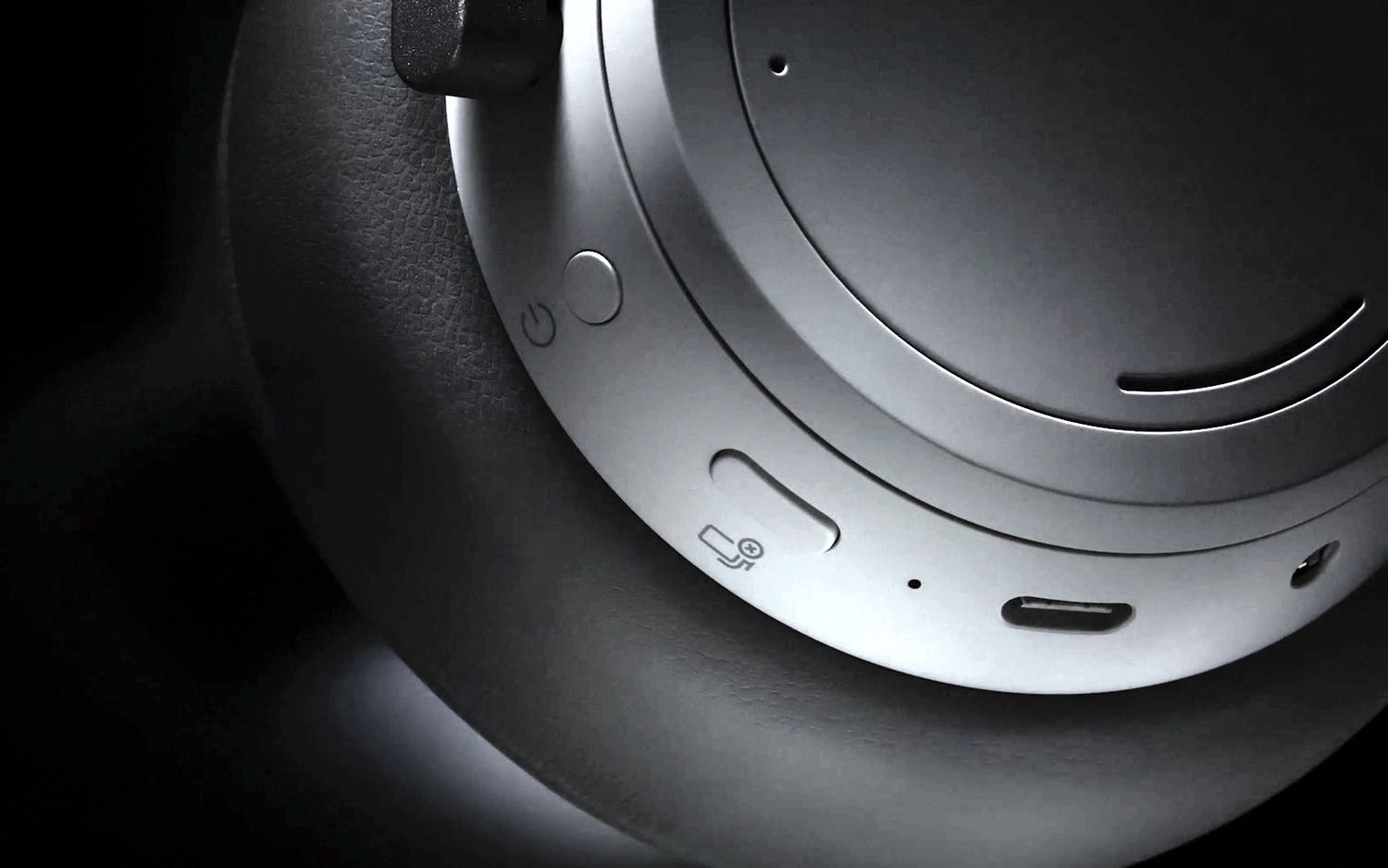
Revving up the audio are 40-millimeter, free-edge speaker drivers that Microsoft claims are "engineered for rich, clear acoustics." It's a fairly accurate claim, although the sound profile places more emphasis on the low end. That being the case, it only seemed right to test some hip-hop and rock songs.
Frequencies were well-balanced on the Foo Fighters' "Learn to Fly," creating a lively atmosphere spearheaded by crashing hi-hats and energetic riffs. The headphones elevated the sound performance of N.W.A.'s "Alwayz Into Somethin'" by placing the spotlight on the song's entrancing, high-pitched synths without compromising vocals.
Frequencies were well-balanced on the Foo Fighters' "Learn to Fly," creating a lively atmosphere spearheaded by crashing hi-hats and energetic riffs.
The headphones do become a bit overzealous with bass at times. Records like The Clash's "Should I Stay or Should I Go" presented plenty of boom, but the guitar portions created some distortion. Mids and highs on the Jackson 5's "I Want You Back" were hidden behind the song's iconic bass line. The background vocals had no presence during the chorus, leaving Michael Jackson's voice to carry the entire song.
One trade-off with having such powerful sonics: noise leakage. Lots of sound bleeds out of these cans. At max volume, my girlfriend could actually identify what I was playing from several feet away. It also managed to disrupt my cat's daytime nap. Using the aux cable was a quieter solution, in spite of the fact that bass and volume sounded much lower than when it was in wireless mode.
One trade-off with having such powerful sonics: noise leakage.
Cortana App
The Cortana mobile app has a plethora of settings to configure, control and set up the headphones. You'll stumble upon shortcut sections to engage Skill actions (organize emails, weather updates); link to music services (Spotify, iHeart); connect to calendars (Outlook, Gmail); and best of all, customize the soundstage.
Opening the Equalizer menu gives you access to five sound presets – Classical, Jazz, Flat, Pop and Rock – as well as the option to create and save your own sound profile. Tweaking the different frequencies for each preset helped improve instrument separation and vocal clarity, especially on bass-heavy tracks. Being able to save these changes to a profile and carry it over onto another media device is dope.
Digital Assistants
The Surface Headphones support Cortana, Siri and Google Assistant. Long-pressing either touch pad or saying the proper wake phrase (like "Hey Google Assistant") activates the feature and lets you shoot out commands. All three operate similarly, though Cortana extends functionality to additional services and skills. Having the ability to get LinkedIn updates, monitor stocks and create voice shortcuts is sweet.
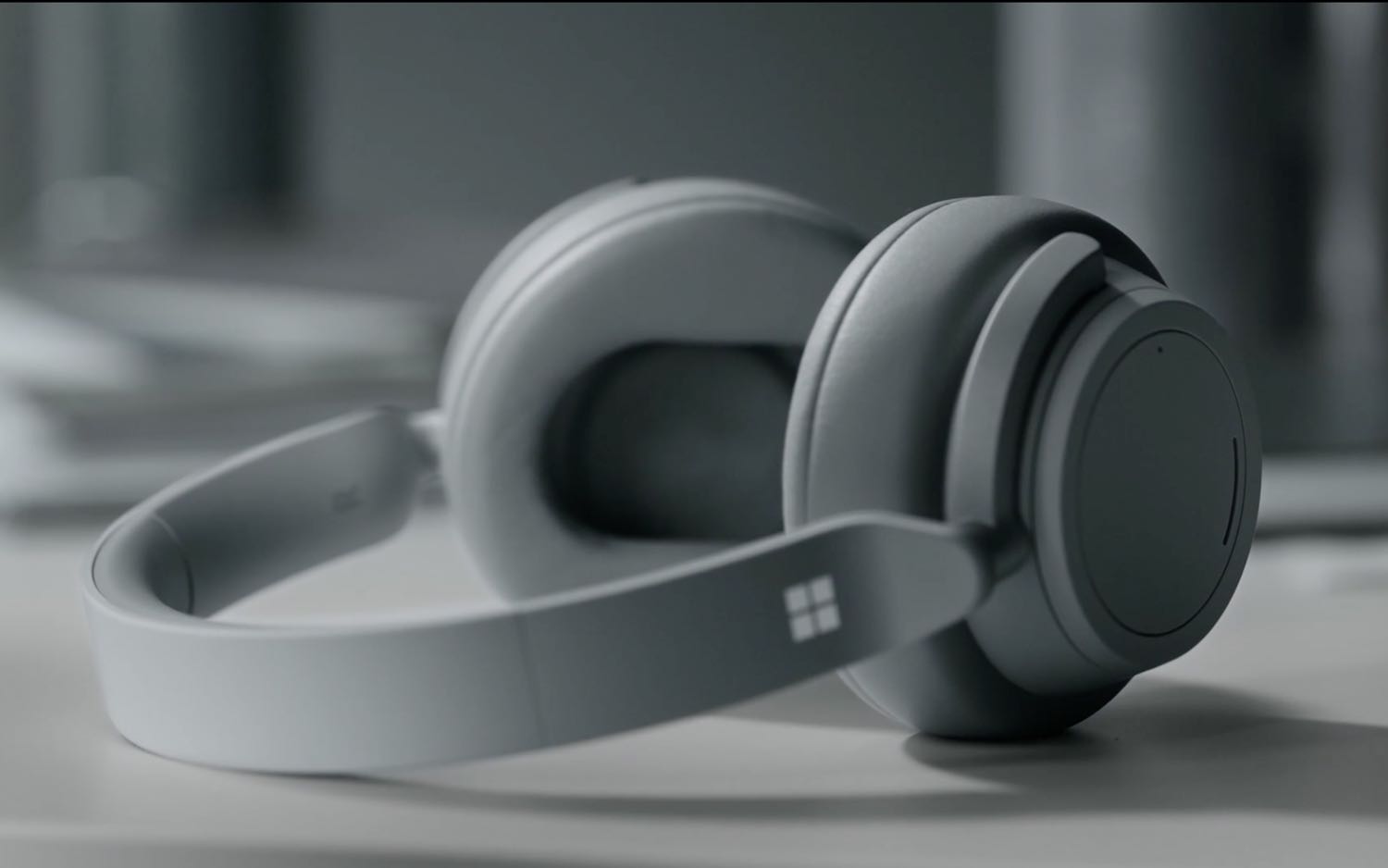
The Cortana experience feels more fluid on Android than on iOS and macOS. Siri often struggled to recognize my voice at times – it somehow mistook "Play 'Black Star' on iTunes" for "Play Plex." My Pixel 3 XL was more cognizant of commands and registered most without a hitch.
Battery Life
Microsoft promises up to 15 hours on a full charge. It's a sufficient amount for a week's worth of moderate listening, but still comes in shorter than the QC35 II (20 hours) and WH-1000XM3 (30 hours). But the combination of Cortana and ANC take a toll on the battery. Luckily, using the headphones in wired mode gets you 50 hours of noise cancellation.
MORE: 9 Cheap Noise-Canceling Headphones (Under $200), Ranked Best to Worst
The Surface Headphones gave me 11 hours of listening time right out of the box, which was great for three days of consistent listening. USB Type-C charging is another clutch feature most will appreciate. I received a full charge in about an hour and a half. Meanwhile, the WH-1000XM3 requires close to 3 hours for 100 percent battery life.
Call Quality
Taking calls on the Surface Headphones is a mixed affair. They perform better than the WH-1000XM3, but not as well as the QC35 II. Conversations on Skype were clear – not so much on phone calls. Two friends said my voice sounded muffled when we were chatting outside, and thought I was on speakerphone. However, the mics picked up vocals better in quieter areas. My girlfriend heard me fine when I called from inside the apartment, but she could tell I was on a headset, due to some minor hissing in the background.
Connectivity
Pairing the Surface Headphones was seamless. You're instantly placed into pairing mode when you power them on for the first time. Even cooler is the ability to pair them with up to 10 devices simultaneously. Normally, this causes issues between audio sources, but I was able to stream Spotify from my Pixel 3XL smoothly while controlling playback via my MacBook Pro.
As seamless as the connectivity is, it's a bummer to see Bluetooth 5.0 missing from the Surface Headphones' spec sheet. Instead, you get Bluetooth 4.2, which still promotes stable connectivity and up to 30 feet of wireless listening. It's worth noting that headphones surpassed this range and hit the 35-foot mark before dropping out.
Bottom Line
First impressions are everything, and the Microsoft Surface Headphones offer more than enough bells and whistles to capture your interest. They have the firepower and features they need to challenge Bose and Sony, but still require a few more upgrades in the audio and noise-cancelling departments before they can be considered to be a true threat.
Noise cancelling aside, these cans are a notable feat in headphone engineering that shouldn't go ignored. The design is stalwart and upscale, making them a sleek companion for any Surface or MacBook. I also liked the fast charging, intuitive controls and wide soundstage.
All things considered, if you want future-proof headphones with dependable noise cancelling and strong audio performance, the $350 Surface Headphones are a noteworthy pickup. Just know that for the same price, you can get better ANC and sound from the QC35 II and WH-1000XM3.
Convinced the Microsoft Surface Headphones are the ones for you? To save some money, check out our Microsoft voucher codes for the latest deals.
Credit: Microsoft
A lifestyle journalist with an affinity for consumer products, Alex has over a decade of experience and has worked with popular publications such as Complex, Thrillist, Men’s Health, Gear Patrol, AskMen, and Hoop Magazine. He currently focuses on audio, reviewing the most coveted headphones in the market for both Tom’s Guide and Laptop Magazine.
